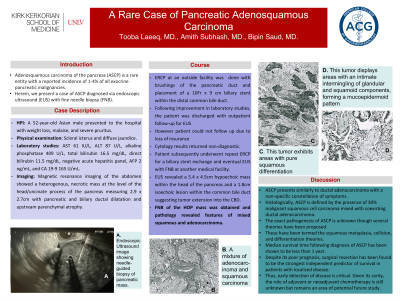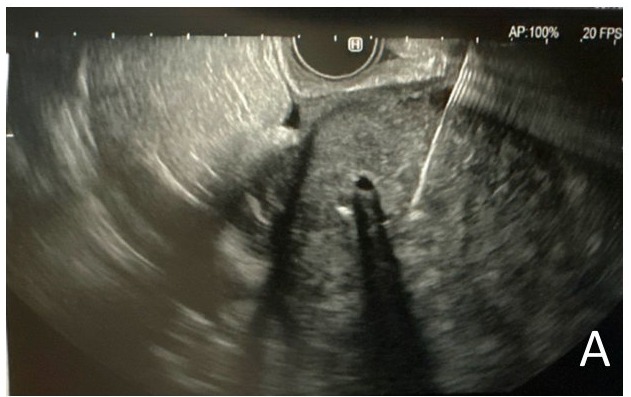Monday Poster Session
Category: Biliary/Pancreas
P1531 - A Rare Case of Pancreatic Adenosquamous Carcinoma
Monday, October 23, 2023
10:30 AM - 4:15 PM PT
Location: Exhibit Hall

Has Audio

Tooba Laeeq, MD
University of Nevada, Las Vegas
Henderson, NV
Presenting Author(s)
Tooba Laeeq, MD1, Amith Subhash, MD2
1University of Nevada, Las Vegas, Henderson, NV; 2Kirk Kerkorian School of Medicine at UNLV, Las Vegas, NV
Introduction: Adenosquamous carcinoma of the pancreas (ASCP) is a rare entity with a reported incidence of 1-4% of all exocrine pancreatic malignancies. Herein, we present a case of ASCP diagnosed via endoscopic ultrasound (EUS) with fine needle aspiration (FNA).
Case Description/Methods: A 52-year-old Asian male presented to the hospital with weight loss, malaise, and severe pruritus. Physical examination was significant for scleral icterus and diffuse jaundice. Laboratory studies were notable for AST 61 IU/L, ALT 87 U/L, alkaline phosphatase 409 U/L, total bilirubin 16.5 mg/dL, direct bilirubin 11.5 mg/dL, negative acute hepatitis panel, AFP 2 ng/mL, and CA 19-9 165 U/mL. Magnetic resonance imaging of the abdomen showed a heterogenous, necrotic mass at the level of the head/uncinate process of the pancreas measuring 2.9 x 2.7cm with pancreatic and biliary ductal dilatation and upstream parenchymal atrophy. Endoscopic retrograde cholangiopancreatography (ERCP) was done with brushings of the pancreatic duct and placement of a 10Fr x 9 cm biliary stent within the distal common bile duct. Following improvement in laboratory studies, the patient was discharged with outpatient follow-up. Cytology results returned non-diagnostic. He subsequently underwent repeat ERCP for a biliary stent exchange and eventual EUS with FNA at another medical facility. EUS revealed a 5.4 x 4.5cm hypodense mass within the head of the pancreas (HOP) and a 1.8cm isodense lesion within the common bile duct (CBD) suggesting tumor extension into the CBD. FNA of the HOP mass was obtained and pathology revealed features of mixed squamous and adenocarcinoma.
Discussion: ASCP presents similarly to ductal adenocarcinoma with a non-specific constellation of symptoms. Histologically, ASCP is defined by the presence of 30% malignant squamous cell carcinoma mixed with coexisting ductal adenocarcinoma. The exact pathogenesis of ASCP is unknown though several theories have been proposed. These have been termed the squamous metaplasia, collision, and differentiation theories. Median survival time following diagnosis of ASCP has been shown to be less than 1 year. Despite its poor prognosis, surgical resection has been found to be the strongest independent predictor of survival in patients with localized disease. Thus, early detection of disease is critical. Given its rarity, the role of adjuvant or neoadjuvant chemotherapy is still unknown, but remains an area of potential future study.

Disclosures:
Tooba Laeeq, MD1, Amith Subhash, MD2. P1531 - A Rare Case of Pancreatic Adenosquamous Carcinoma, ACG 2023 Annual Scientific Meeting Abstracts. Vancouver, BC, Canada: American College of Gastroenterology.
1University of Nevada, Las Vegas, Henderson, NV; 2Kirk Kerkorian School of Medicine at UNLV, Las Vegas, NV
Introduction: Adenosquamous carcinoma of the pancreas (ASCP) is a rare entity with a reported incidence of 1-4% of all exocrine pancreatic malignancies. Herein, we present a case of ASCP diagnosed via endoscopic ultrasound (EUS) with fine needle aspiration (FNA).
Case Description/Methods: A 52-year-old Asian male presented to the hospital with weight loss, malaise, and severe pruritus. Physical examination was significant for scleral icterus and diffuse jaundice. Laboratory studies were notable for AST 61 IU/L, ALT 87 U/L, alkaline phosphatase 409 U/L, total bilirubin 16.5 mg/dL, direct bilirubin 11.5 mg/dL, negative acute hepatitis panel, AFP 2 ng/mL, and CA 19-9 165 U/mL. Magnetic resonance imaging of the abdomen showed a heterogenous, necrotic mass at the level of the head/uncinate process of the pancreas measuring 2.9 x 2.7cm with pancreatic and biliary ductal dilatation and upstream parenchymal atrophy. Endoscopic retrograde cholangiopancreatography (ERCP) was done with brushings of the pancreatic duct and placement of a 10Fr x 9 cm biliary stent within the distal common bile duct. Following improvement in laboratory studies, the patient was discharged with outpatient follow-up. Cytology results returned non-diagnostic. He subsequently underwent repeat ERCP for a biliary stent exchange and eventual EUS with FNA at another medical facility. EUS revealed a 5.4 x 4.5cm hypodense mass within the head of the pancreas (HOP) and a 1.8cm isodense lesion within the common bile duct (CBD) suggesting tumor extension into the CBD. FNA of the HOP mass was obtained and pathology revealed features of mixed squamous and adenocarcinoma.
Discussion: ASCP presents similarly to ductal adenocarcinoma with a non-specific constellation of symptoms. Histologically, ASCP is defined by the presence of 30% malignant squamous cell carcinoma mixed with coexisting ductal adenocarcinoma. The exact pathogenesis of ASCP is unknown though several theories have been proposed. These have been termed the squamous metaplasia, collision, and differentiation theories. Median survival time following diagnosis of ASCP has been shown to be less than 1 year. Despite its poor prognosis, surgical resection has been found to be the strongest independent predictor of survival in patients with localized disease. Thus, early detection of disease is critical. Given its rarity, the role of adjuvant or neoadjuvant chemotherapy is still unknown, but remains an area of potential future study.

Figure: A. Endoscopic Ultrasound image showing needle guided biopsy of pancreatic mass.
Disclosures:
Tooba Laeeq indicated no relevant financial relationships.
Amith Subhash indicated no relevant financial relationships.
Tooba Laeeq, MD1, Amith Subhash, MD2. P1531 - A Rare Case of Pancreatic Adenosquamous Carcinoma, ACG 2023 Annual Scientific Meeting Abstracts. Vancouver, BC, Canada: American College of Gastroenterology.

